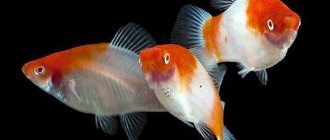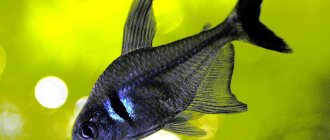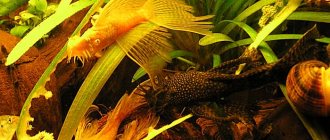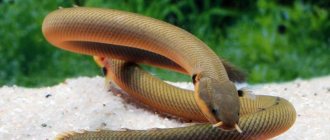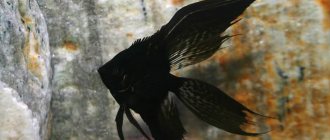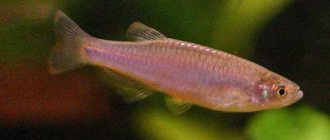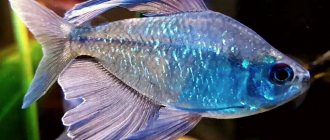Clarius photo
Usually, when reading the description of this or that aquarium fish, you can come across epithets: bright, beautiful, graceful. This article is not about that at all. Material especially for fans of the oxymoron and the movie “Alien”, who have long dreamed of their own cute monster! The Clarius catfish or Clarias is a kind of Sphynx cat from the world of fish, because like Sphynxes, which have no hair, the Clarius has no scales!
Description
In suitable conditions it grows up to 100 cm. Lungbreathing. The gills absorb oxygen dissolved in water, and the epibranchial semblance of the lungs absorbs atmospheric oxygen. It survives in unfavorable conditions, but in critical cases it crawls to another body of water.
The skin is covered with mucus, which protects it from scratches on land. The mucus causes a painful or allergic reaction in humans.
Cases of “transitions” of 4–5 kilometers have been recorded. For this he received the nickname “walking catfish”.
Appearance
The torso is elongated, eel-shaped. The dorsal fin runs along the torso and caudal peduncle, is needed for vertical stabilization and defense against other predators, and includes 60–75 feathers with poisonous secretions. The anal fin is also extended, oblong, with 40–60 feathers. And also the poisonous pectoral fins with powerful spines upon contact cause an unpleasant wound to a person, comparable to a wasp sting.
The propulsion caudal fin is small in size. Features: lush tentacle mustaches. Four on the upper and lower lip. Used to lure food and navigate in opaque water. The eyes are round and small, but do not suffer from color blindness. Huge mouth.
The skin is thick, smooth, devoid of scales, usually brown with a gray tint. Biologists have developed aquarium hybrids with a spotted color. From time to time, red-eyed albino individuals are encountered.
View this post on Instagram
#clarias#aquarium
A post shared by GARIK (@garynych888) on Oct 29, 2021 at 11:29pm PDT
The hunting method is drawing water with nutritious contents into the mouth or attacking the victim from an ambush.
Clarid catfish in an aquarium grows to 0.2–0.6 m.
Inexperienced aquarists confuse it with the sacbranch catfish. The difference is in the length of the fin: in the sacbranchial it is much shorter.
Behavior
Constantly hungry and with a difficult temperament. It comes into violent conflict with other species. It is better to keep it separately. If this is not possible, neighbors are selected based on their comparable size and aggressiveness.
Forms a stable pair with the selected female. Two pairs cannot be placed in the same aquarium, as they will fight.
Spends the day in hiding. Active at night. Loosens the soil: equipment and plants suffer.
Lifespan
Depending on the species, they live 8–20 years.
African catfish from the Moscow region: how to make money by growing unusual fish
Alexey Valuev, a resident of the Moscow region, raises African catfish, whose meat is considered dietary and contains almost no bones. Since this is an unfamiliar product for the Russian buyer, its sales were slow for the first few years. Now catfish “from Valuev” are served in restaurants in Moscow, Moscow region, Irkutsk and Yekaterinburg. The owner of the African Catfish farm, Alexey Valuev, told the Biz360.ru portal about how to promote a new product and what difficulties await the breeder of African fish in Russia.
Dossier
Alexey Valuev
, 42 years old, founder and owner of a farm (Ruzsky district, Moscow region). Graduated from the Moscow State Open University named after Chernomyrdin with a degree in organization management. In 2014, he founded a farm for breeding African catfish, investing about 2 million rubles in this project.
“There should be no bones in fish”
Alexey Valuev's first business idea was to create a pond fishery. He was prompted to do this by dissatisfaction with the fish on the shelves of shops and markets. According to Valuev, due to the low quality of the feed used, it was too loose and “watery”.
A suitable offer to purchase land was only 1000 km from Moscow. Alexey decided to abandon this idea and look for options closer to the capital. While searching, he accidentally saw information about breeding African catfish and began to study it.
It turned out that the African catfish is a river fish, which in “nature” is found in the rivers of Africa. But under artificial conditions it is bred all over the world. Its main advantage is meat, rich in protein and amino acids. The fat content in it is only 4%, and the calorie content is no more than 102 kcal (for comparison: the calorie content of salmon is 140-200 kcal, the fat content is about 6%). Therefore, African catfish is classified as a dietary product.
Another important advantage is the unpretentiousness of this fish when breeding. She doesn't get sick and doesn't need to add antibiotics to her food. African catfish can be grown at fairly high densities. It is contained in quantities of up to 350 kg per cubic meter of water - this is several times more than the “norm” for other types of fish. African catfish grow quite quickly (in 4 months it reaches a weight of 1 kg) and does not need growth accelerators.
“In big cities, many people are thinking about proper nutrition. And the African catfish fits these purposes perfectly. There is practically no fat in it. It is collected not in the meat, but separately, like in chicken. For many, it is also important that African catfish has almost no bones. When I was looking for fish to breed, I took the advice of my wife and children: there should be no bones in the fish. They are essentially absent only in sturgeon and African catfish,” explains Alexey Valuev.
Equipment “for beginners”
Alexey began studying African catfish and its breeding in 2013. There was very little information “on the topic”, since this fish was almost never cultivated in Russia.
After a year of searching, Alexey found an advertisement for the sale of the equipment he needed for breeding catfish in captivity. The most important and expensive part of such an installation is water purification filters. First, a mechanical filter takes a large suspension (more than 40-60 microns) and discharges it into the sewer. Then the water passes through a biofilter in which bacteria grow. They convert nitrites into nitrates, which makes the water more suitable for fish. Only after this does the water go into the pools with catfish.
Alexey planned to buy caviar for fish breeding at the Institute of Freshwater Fisheries in Dmitrov near Moscow. It turned out that they don’t deal with African catfish there. But he was given contacts of those from whom it was possible to purchase caviar of this fish in Russia.
Alexey Valuev rented premises in the Ruzsky district of the Moscow region and installed the purchased equipment there. But soon after the start of its use, it turned out that the purification filters could not cope with the preparation of water for the declared volume of fish.
“When some new topic appears in Russia, there are always charlatans who declare themselves experts. By deceiving customers, they sell something that is not supposed to work. The problem was that we didn't know what we should get in the end. And I trusted the equipment manufacturers, who assured me that they themselves grow fish on it. But in reality, it was not working: it is simply “sold” to all beginners,” states Alexey.
Second try
Having gained first experience and consulted with fish farmers, Valuev decided to act differently. In 2015, he bought the necessary pools and filters and assembled them into the system himself, rather than using ready-made solutions. This time everything worked as it should, and after 4 months the first batch of fish grew in the installation. The equipment used allows us to grow about 5-7 tons of fish monthly. Thus, the path from the idea to the first serious result took about two years.
However, new problems not related to the equipment soon emerged. It turned out that the feed supplied by Russian producers is very unstable in quality. For example, they may have too high solubility in water. They leave a suspension that even a 40-60 micron filter cannot “catch”. Feed particles settle in containers, which is why they have to be drained and cleaned periodically.
This does not happen when using imported feed, but they are much more expensive. While Alexey Valuev uses domestic feed, he is still looking for reliable suppliers. Good feed will increase fish stocking density without compromising water quality.
Investments in operating equipment amounted to about 1.5-2 million rubles. There was no need to take out loans - Alexey invested in the project from his own funds.
Currently, part of the fixed costs is the cost of bioloading. This is a special plastic around which bacteria grow, “working” in the biofilter. One such installation costs 250,000 rubles. Requires serious costs and maintaining the desired water temperature. It should always be around 27 degrees. In addition to the required degree of water purification, this is the second important condition for successful breeding of African catfish.
“We only sell what is asked for”
Simultaneously with growing the first batch of fish, Alexey Valuev began searching for buyers. He decided to start with Moscow markets. But having visited almost all the trading floors open in the city, I could not agree on a delivery with anyone. It turned out that owners of markets and retail outlets prefer “proven” products and are distrustful of new products.
“Our fish is of high quality and inexpensive, so I was counting on the interest of traders. Moreover, its meat has an appetizing red color; its fillet looks very advantageous when sliced on ice. But in the markets they told me that “they only trade what they ask.” When I told the owner of one of the markets about my fish and its advantages, she replied: “So what, we will have to explain everything to every buyer in the same way?” notes Alexey.
Then he tried to sell fish in stores in the Istrinsky district of the Moscow region, but the “human factor” prevented him. All the fish in store aquariums died within 2 days. The reason was that the water that was poured into the aquarium from the tap was too cold for the African catfish. After this, the stores decided to refuse supplies.
To restaurants and retail
After failures in the “market” direction, Alexey Valuev decided to change tactics: he brought his product to Moscow restaurants. We managed to conclude supply contracts with some of them. Subsequently, the number of clients gradually increased. Now about 20-30 restaurants buy fish from Alexey Valuev.
“If a competent chef tries our fish, he understands that there is no other similar product on the market now. African catfish meat contains no pathogens at all. Fish can be eaten raw - for freshwater fish this is nonsense. I think it’s safer to eat than salmon,” says Alexey.
The main problem in promoting the product among chefs is that for many of them it is “not clear what to do with this fish.” To clearly explain the capabilities of African catfish, Alexey invited the famous chef Vasily Emelianenko to record several video recipes.
In these videos, Vasily prepares pancakes stuffed with catfish, catfish in chocolate, kutabs with rice dough, and also “rack of catfish.” This fish has meat on both sides of the ribs and can be cooked in the same way as pork ribs. In the future, it is planned to release a small brochure with recipes, which will be included in private orders and given to chefs.
After a year of working as a restaurant supplier, Alexey Valuev opened an online store for retail customers. Now their orders account for about 30% of total sales.
Each application from the site goes to Alexey’s email. The client is contacted and the order and delivery address are agreed upon. From the moment of application to receipt of the goods in Moscow, 2-3 days pass. If the client promptly confirms the order, it is possible to complete the order within a day - fish deliveries to Moscow occur on a daily basis.
“The main disadvantage of our “retail” direction is that we sell only one type of fish. And many buyers have become lazy and want to order everything they need on one site. But we are expanding our offer to include smoked fish and sausages. We are starting to make unique dry-cured fish sausages and will be launching new products. The choice on the site will become wider, and it will be somewhat easier to attract buyers,” Alexey shares his plans.
Customers from other cities and regions of Russia are gradually beginning to appear - both among restaurants and among retail clients. Visitors to one of the restaurants in Yekaterinburg and Irkutsk can try African catfish. In the coming months, it is planned to begin deliveries to Samara and Krasnoyarsk. Retail orders to other regions are delivered by a transport company.
Sausage at the fish fair
Currently, the African Catfish farm sells 17 types of products. Among them are chilled fish, as well as finished products from it: smoked fish, minced meat, sausages. The fish is prepared at several partner production facilities. One of them is engaged in smoking, the others – in the production of minced meat and sausages.
Hot and cold smoked fish became available for sale from Alexey Valuev in 2021. It is ordered by both private clients and restaurants.
“One of the chefs tried hot smoked fillet and compared it to sturgeon. After that he said to me: “Why didn’t I know this product before?” Starting in the fall, he will introduce our smoked catfish to the menu of his restaurant,” says Alexey.
The owner of the African Catfish farm developed recipes for making fish sausage together with a specialist in “regular” meat sausages. According to the entrepreneur, they actually applied “meat” technologies to fish. Dried fish sausages mature for 45 days, and the same amount of time is needed to obtain the finished product. One of Alexey’s new ideas is thin sausages. They ripen twice as fast as regular ones.
“In May, the Fish Week festival was held in Moscow, which I was not able to participate in. But the guys who smoke my fish decided to trade there. In addition to the fish, we gave them about 100 kg of dry-cured sausage, which sold out without a trace. Everyone was interested: you come to a fish fair, and suddenly there’s sausage,” says Valuev.
Price issue
A kilogram of chilled African catfish costs retail buyers from 360 to 720 rubles. The difference in price depends on the method of cutting the fish (carcass or fillet). The price for smoked fish starts from 1100 rubles per kilogram. The most expensive product, raw smoked sausage, costs 3,000 rubles per kilogram.
Restaurants order from 10-15 kg of products per delivery, the cost of such orders is from 3,000 rubles. The average retail order in an online store costs the buyer 500-1000 rubles.
Every month, the African Catfish Farm produces about 5-7 tons of fish. According to Alexey Valuev, it was possible to achieve payback only in 2021 - 3 years after the start of production.
On the first search page
The majority of clients learn about the African Catfish farm from social networks, usually on Facebook. Clients who come through recommendations are also starting to appear. Among them are both ordinary customers and restaurant chefs.
The number of visitors to your own website has formed gradually. However, no money was invested in its promotion. Due to the uniqueness of the product, the site organically rose to the top of search engines for the query “African catfish.” Now the project website appears on the first page when searching.
Like any “restaurant” supplier, Alexey Valuev knows very well: getting a meeting with chefs can be very difficult. As practice has shown, the easiest way to attract their attention is at specialized exhibitions and forums. That's why he regularly takes part in events where he can talk to restaurateurs in a more informal setting. For example, in May, the owner of the African Catfish farm introduced specialists to his product at the Gastreet-2018 restaurant forum in Sochi.
“Participation in events is a serious item of our expenses. But we are going through this so that people learn about our product and try it,” says Alexey Valuev.
One of the main difficulties in promoting a product is the well-established opinion that “catfish should smell like mud.” As Alexey explains, this is the smell of fish that live in stagnant water: in natural creeks or in fish farm ponds. This smell is often found in Astrakhan catfish, which are caught in river backwaters. If you grow fish in running water, as is done on Valuev’s farm, there is no “muddy” smell.
“When I invited my mother to try our catfish, she refused to eat it because “it would smell like mud.” That's the first thing everyone tells me. But in our installation, the water is completely renewed every one and a half to two hours. Since the water does not stagnate, the fish does not smell. By the way, after my mother tried my catfish, she almost never buys fish in stores,” says Alexey.
Competition
According to the observations of Alexey Valuev, in Russia there are no more than one or two large farms where African catfish are raised using professional equipment. Mostly small “handicraft” industries are engaged in breeding this fish. As a rule, their owners are looking for the cheapest equipment or trying to assemble it themselves.
Some competitors offer their products to restaurants with which Alexey works or tried to work. Their prices are not much lower compared to the offer of the Ruza farm. But, according to the entrepreneur, many restaurants are ready to change a reliable supplier due to savings of 20-30 rubles per kilogram.
“Everyone wants to reduce costs. It's common practice for restaurants to take fish that smells like mud because it's cheaper. Then it is soaked in milk for a day, cooked and sold. It's easier to spend money on a carton of milk than to buy good fish. Therefore, we did not grow trout or sterlet. It is difficult to convince a person that your fish is cooler than others, and therefore more expensive. In my opinion, this is much more difficult than offering a completely new product for the market,” says Alexey Valuev.
What's next
To be more profitable in any production, you need to produce goods in larger quantities. Therefore, in the coming months, the founder of the African Catfish farm plans to purchase new installations. Their capacity will be approximately the same as that of the existing installation - about 5-7 tons of fish per month. The purchase of new equipment will require about 2 million rubles.
Another development plan is related to the creation of conditions for fish processing. This is due to good demand for finished products. Own production is also necessary in order to “enter” store chains. They trust manufacturers much more than those who manufacture their products “outside”.
“We already have some experience with the stores where we plan to enter. But it is not yet clear whether our product will be sold, whether it will be offered to customers. If not, it will simply lie on the display case until it deteriorates. We are very dependent on sellers here - like everyone who enters the market with a new product,” states Alexey.
In his future plans, Valuev hopes to create a “pool” of African catfish producers. According to his idea, in the event of a large order from chains or processors, he will be able to connect other farmers to jointly fulfill it. But to implement this idea, it is necessary that all participants in the “pool” produce a product of consistently high quality.
Such a merger will also help solve the feed problem common to all African catfish producers. Joint orders of large volumes will allow you to switch to higher quality feed without a significant increase in costs.
Kinds
The genus Clarii includes 61 species. Clarias species differ in size and color. Hunting methods and habits are the same.
Clarias of the Nile
It is also marbled (African, Clarias gariepinus) common in Africa, Asia Minor and South Asia. In nature, they reach a length of 1.7 m and a weight of 60 kg. The main color takes on the color of the water. With black spots.
Produces and receives electrical signals that warn relatives when hunting “boundaries” are violated. Tolerates brackish water. Lives up to 8–10 years. In Europe and Russia it is bred in nurseries. Marbled catfish in an aquarium grow up to 1 m.
Clarias Angolan
And also the spotted clarius (karmut, sharmut, Clarias angolensis) migrated from Africa to South Asia. Under natural conditions, up to 0.5 m. In captivity, up to 0.35 m. The abdomen and main tone are white or cream. With purple, brown or black spots.
Clarias frog
Or commercial catfish (Clarias batrachus). Distributed in the South Asian region, although it has African roots. The size and weight (1–1.3 kg) are similar to the Angolan. Light belly, olive sides and black back.
Habitat of Clarius
Clarius pug
The spotted or Angolan clarius (Clarias batrachus, Walking Catfish) is native to the freshwater rivers of Africa. During droughts, when African rivers dry up, clarius, due to the peculiarities of their body structure and the ability to breathe atmospheric air, are able to migrate to new bodies of water overland. Currently, the Angolan Clarius is found in countries such as Nepal, Vietnam, Bangladesh, Thailand, Sri Lanka, India. It is found in US water bodies, where it was introduced artificially for breeding and has become a serious problem for the fauna of American rivers. The large and predatory clarius, in the absence of natural enemies, grew in large numbers and became a serious threat to the population of local fish species. The only reason Clarius has not been able to spread throughout America is its intolerance to cold weather. In winter, the catfish dies.
Content
The recommendations are the same for all types.
Aquarium
For young members of the family, a container of 0.1 cubic meters is suitable. A specimen that has matured and grown to half a meter will need a two-hundred or three-hundred-liter container. Grows quickly.
A secured lid is required. Otherwise he will jump out and hide.
Water parameters
Catfish is thermophilic. A water temperature of +26 °C is considered satisfactory.
The chemical composition of water is not important for keeping catfish. But if you plan to breed clarius, you need to bring the indicators to the following values: pH 6–8, hardness - up to 8°.
At least once a week, at least a third of the water is replaced with pre-prepared water.
Plants
The roots must be strong, otherwise the catfish will dig up the plant. Rough leaves are necessary, otherwise it will nibble. Grow in securely secured pots.
There are such individuals that nothing helps. In this case, you will have to say goodbye to the planted greenery.
Suitable plants are those that float in the water column and are inedible due to their strength.
Priming
Large pebbles will save you from problems with the digger. Sand should not be used. The catfish will make a lot of haze. Cleaning devices will not help: their performance is insufficient and they will quickly clog. If the noise of moving pebbles annoys you, there is no need for soil.
Decorative design
Clarias catfish loves resting shelters. Use pre-prepared driftwood. A grotto and massive stones will do. A playful pet will try to move and dig up objects.
Equipment
Clarias is a lungfish and demersal fish. Therefore, you need access to the surface and a clean, oxygenated environment. Aeration and filtration are necessary. The violent nature of the inhabitants will make it difficult to use the internal filter.
A siphon for collecting waste is required.
Lighting
Shouldn't be too bright and is intended more for plants. The standard one is also suitable (0.5 W per 1 liter of water).
Clarium catfish farm
It is better to create a minimal fishery using a closed-loop water supply (RCWS) installation. For this:
- They dig a special aquarium pool with a volume of 12 cubic meters and a wall height of more than 1 m.
- For zoning (adults, adolescents, fry), the reservoir is divided using a chain-link mesh.
- Install filtration systems. It is better to combine mechanical and biological mechanisms. To collect feces, a sump is made in which special bacteria decompose the dirt. In addition, you will need a spare tank to store clean settled water.
- You definitely need a powerful pump to drive water through the reservoir and an oxygen generator that performs the function of aeration.
- An automatic feeding system is installed, in which the feeding dosage and frequency of feeding are programmed.
- Heating systems and means of insulating the reservoir when the air temperature drops are provided.
Nile catfish can be raised in a regular pond, but the UZVS helps to quickly and efficiently raise a healthy stock of fish.
Some hobbyists are also experimenting with growing clarius in barrels, tanks, and basements, but so far none of them have been able to achieve acceptable profitability.
Reproduction
Breeding Clarius requires large containers.
Sex differences
It is possible to distinguish the sexes after maturation at 2–3.5 years, depending on the species. Males are broad-browed and brightly colored. In females, the abdomen protrudes slightly.
Getting offspring
First, the wayward adult Clarias catfish chooses a female to mate with. To do this, several individuals are grown in a common aquarium with a water volume of 70–100 liters per individual. Future parents stay close and often touch their whiskers, and aggression increases.
The couple is isolated in a pre-prepared container with seaweed and a grotto.
After the end of spawning, the female lays eggs. If there is no grotto, then the Clarias dig a hole in the ground or find another suitable place. Until the larvae hatch, the clutch is guarded by the male.
After a couple of days, the offspring appear. After a week, they begin to swim and feed themselves. Parents are removed due to the threat of eating the young.
Overeating threatens Clarias fry with death. For this reason, the fry are fed 4–5 times a day.
They are fed with special compounds, chopped and then whole live food. They grow intensively. Larger juveniles are placed separately.
Features of character and behavior
Clarius catfish likes to be alone, rarely, but can create a pair, and then they spend all their time together.
These are active and strong fish. Most of the time they stay near the bottom; they like to dig the soil, lie on the bottom, raising their upper body. Unlike other species, their activity does not depend on the time of day. The pet gets used to the owner and allows itself to be petted, and over time it learns to eat from hands.
Only large fish that can fend for themselves are suitable as neighbors:
- some types of barbs;
- cichlazomas;
- armored catfish;
- paku.
Clarius will eat small fish without hesitation.
Diseases
- Skin damage from fights and hooligan behavior causes mycoses. They appear as light threads at the affected areas. Self-treatment can lead to the death of fish. The help of an ichthyopathologist is needed.
- Ulcers. And also from scratches. A solution of potassium permanganate helps. 0.2 g of crystalline substance per 10 liters of water in an aquarium with a complete replacement within 10–12 hours. It is more effective to place 0.5 g of the drug per 10 liters of soft water (up to 4 °C) in the prepared solution for 15–20 minutes.
- Ichthyophthyriosis. Caused by ciliates brought in from outside. They are bred by adding potassium permanganate and copper sulfate to the aquarium. If it doesn’t help, use Bicillin 5.
- Keeping it in a cramped container or without aeration risks nitrate poisoning. Expressed by lack of activity, spots on the fins, ulcers.
Breeding
In nature, the clary catfish breeds during periods of high water during the rainy seasons, and chooses lowlands and flooded floodplains for spawning.
There is no natural factor in the artificial environment, so farmers use hormonal stimulation, for example, with Ovaprim, Dosa, Human Chorionic Gonadotropin, the pituitary gland of brood catfish, carp, tilapia and frogs.
In order to create a high-quality broodstock, the healthiest and strongest Clarias are selected and placed in an area with enhanced nutrition. After stimulation, the temperature is raised above +18 °C. Females prepare a kind of nest in thickets of aquatic plants, and lay eggs there.
If farmers want to collect eggs, they create imitation nests artificially. She is fertilized with the milk of males and transferred to special aquarium incubators.
Baby catfish, immediately after they have absorbed the yolk sac, begin to be fed with a mixture of cattle brains and egg yolk; after 5 days, the juveniles are transferred to another area, fertilized with bird manure and populated with zooplankton.
On small farms, juveniles may be fed mixed feed.
After a month, the young animals are sorted, those individuals who have gained 5-8 grams are transferred to intensive fattening, the norm for this period is 10 grams.
Some African farms are now producing genetically modified individuals for the tribe. The success of fish farming depends on the quality of breeding stock.
Reviews
Claims:
- It is impossible to feed enough.
- The amount of food does not matter; it will snack on its aquarium mates.
- He arranges the premises himself. It makes noise at night.
- Doesn't get along well with plants. He even eats shellfish with the shell.
- Jumps out of the aquarium.
What they value:
- Individual character. There are non-aggressive individuals suitable for a community aquarium.
- When kept separately, it becomes attached to the owner. He will find out. Allows you to pet it. Playing. Tries not to hurt. He is wary of strangers.
- Omnivorous. Does not require separate food.
Feeding Clarius
Clarius photo
Clarius is a typical predator that does not disdain carrion. You can feed small live or dead fish. You can also feed worms, flakes or pellets. Clarius is capable of gobbling up anything, however, his body is not able to digest the meat of poultry and mammals normally and such feeding will inevitably cause problems with the gastrointestinal tract. Therefore, it is better to feed them with branded sinking food for catfish like Tetra Tablets TabiMin XL.
It would be useful to note that when purchasing any dry food, you should first of all pay attention to the date of its manufacture and shelf life, try not to buy food in bulk, and also store the food in a closed state - this will help to avoid the development of pathogenic flora in it.
Photo
Adviсe
- It does not tear the roots of plants in pots, but chews leaves. Not all varieties of greens are suitable.
- A catfish accustomed to dry food does not eat its neighbors.
Clarias catfish is an active fish, 0.3–1 m in size. Aquarium from 150 liters. With filtration and aeration. With or without rocky soil. Predator. Does not get along well with other species. Unpretentious in content. Omnivorous. Lives 8–20 years.
Previous
FishFeatures of reproduction and childbirth of a pregnant female swordtail
Next
Fish Tips for keeping a large cleaner - brocade catfish!
Compatibility of Clarius with other fish
Clarius photo
When describing the compatibility of the same cichlids, they usually say cocky, aggressive... This is not entirely applicable to Clarius. You can't say that he is aggressive, he just eats. Like the common catfish, the Clarius swallows everything it can physically swallow. Moreover, it doesn’t matter to him whether the prey is alive or dead.
In a general aquarium, it will eat even fairly large and predatory fish. Neighborhood is possible only with adult arowanas, pacu, astronotuses, and other large catfish. But it’s better not to take risks and house Clarias alone or as a couple. Catfish that have found a mate do not show aggression towards each other and live in peace and tranquility.
